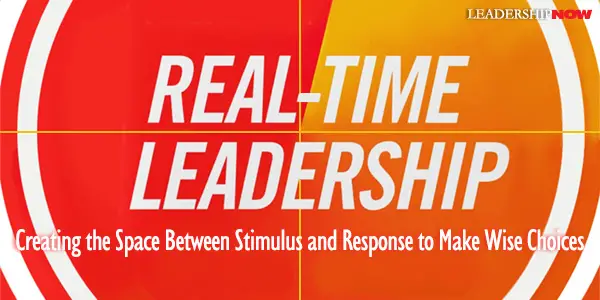 |
 |
05.12.23

Real-Time Leadership: Creating the Space Between Stimulus and Response to Make Wise Choices
MAKING the most of every moment requires that we slow down and create some space between the challenges that are thrown at us and how we react. When faced with high-stakes challenges, we too often rely on our instincts and pattern recognition that we have developed through years of experience and plow ahead. When the challenge or opportunity is new, relying on our instincts can take us in the wrong direction. To master pivotal moments in real-time, David Noble and Carol Kauffman offer the M.O.V.E. framework in Real-Time Leadership: Find Your Winning Move When the Stakes Are High. Handling high-stakes, high-risk leadership challenges requires preparation and practice. The M.O.V.E. framework helps you to find, open, and use the space you create between the challenge and your response. The framework is described briefly this way: M: Be Mindfully Alert “Mindful Alertness in high-stakes situations means being exquisitely aware of what is needed from you as a leader at this exact moment, so you can lead in real time.” It means being “precise about and flexible with where you put your attention.” To be mindfully alert is about overcoming your instincts. If you automatically turn to your standard playbook you are not being mindfully alert. Being mindfully alert allows you to create space in real time. Every challenge you will face as a leader will involve all or some of what they call the Three Dimensions of Leadership: First is the External Dimension that refers to high-stakes that you want and need to achieve that come from your own aspirations or those that are handed to you. Next is the Internal Dimension is about your character, emotional regulation, values, and who you need to become as a leader to meet those external challenges, goals, and priorities. Finally, there is the Interpersonal Dimension is about how “to lead in the way others need, not how to lead in the way that you’d personally prefer. In any interaction, a leader must have multiple ways to respond to unlock the potential of others.” O: Generate Options Before we move into action, we increase our chance of success if we consider all of our options first. Those options revolve around four basic stances: Lean In (take an active stance), Lean Back (take an analytical stance), Lean With (collaborate with others), and Don’t Lean (be still and take in all that is around and within you to that creative wisdom can surface). The authors call it moving from willpower to waypower—generating at least four options to achieve each of your external priorities and rank them. The stance you employ needs to match the needs of the people you are with. V: Validate Your Vantage Point We need to understand our perception of the situation. Am I right? Or have I gotten it wrong? Am I seeing clearly or is my perception distorted by my own biases or by some other factor? Do I see things from other people’s perspective? Is the stance I am taking the right one? What if I used a different approach? We need to also consider if our vantage point is too high-def (fine-grained detail) or the other extreme, too grainy (just the basic details). Sometimes the situation calls for a wide view especially where creativity is called for. At other times we need to take a narrow focus. These considerations help to determine how best to spend our time. E: Engage and Effect Change Begin by communicating your intent. Boost your signals by doing only what you can do and leave the rest to others. Most leaders will find that their job is not to be the specialist, but the generalist. The authors also address the Real-time challenges of stepping into a new role. The key, they say, is changing your vantage point. Once you have gained clarity on your new vantage point, you can then begin to apply the rest of the MOVE framework. Adjust your behavior to the new relationship dynamics required by your new role. Let people get to know you as much as you can. Remember, too, “You must identify with the whole organization, not just the parts you’re comfortable or familiar with.” Depending on your situation (and time), you may not need to apply the MOVE framework in order. Think of the four elements as a checklist and when one area doesn’t check out, start there. For example, ask yourself, “Do I feel that I have several options I can call on to achieve my priorities, and not just depend on my default approach?” If not, start working there to broaden your options. Great leaders “create a space between stimulus and response and exploit that space—whether it’s seconds, hours, or longer—to make wise choices. The most extraordinary leaders live in that space.” They are centered. It takes practice and commitment to get there. When a group of monks were frustrated because they felt their powers of concentration and mindfulness had plateaued, even though they practiced nonstop, they approached the Dali Lama for advice. The Dali Lama paused for a moment before playfully replying, “I can say that over the past forty years of practice, I have noticed … some improvement.” 
Posted by Michael McKinney at 06:31 AM
|
BUILD YOUR KNOWLEDGE
 

How to Do Your Start-Up Right STRAIGHT TALK FOR START-UPS 
Grow Your Leadership Skills NEW AND UPCOMING LEADERSHIP BOOKS 
Leadership Minute BITE-SIZE CONCEPTS YOU CAN CHEW ON 
Classic Leadership Books BOOKS TO READ BEFORE YOU LEAD |